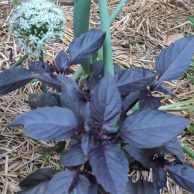 Basil is one of the great culinary pleasures of summer, and it’s definitely NOT TOO LATE to plant Basil and enjoy a good crop! Basil plants are beautiful, grow equally well in the ground or in pots, thrive in hot weather, provide a continuous, bounteous crop, and Basil’s many different flavors are essential to a variety of distinctive cuisines. It can be used fresh, dried, or frozen in oil or as pesto. Though basil leaves lose most of the aromatic oils when dried, we have still found that basil dried from your garden is so much more flavorful than commercial dried basil.
Basil is one of the great culinary pleasures of summer, and it’s definitely NOT TOO LATE to plant Basil and enjoy a good crop! Basil plants are beautiful, grow equally well in the ground or in pots, thrive in hot weather, provide a continuous, bounteous crop, and Basil’s many different flavors are essential to a variety of distinctive cuisines. It can be used fresh, dried, or frozen in oil or as pesto. Though basil leaves lose most of the aromatic oils when dried, we have still found that basil dried from your garden is so much more flavorful than commercial dried basil.
ALL of our Basil plants are organically grown!
Growing
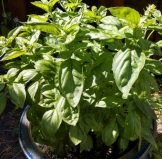
Sweet Basil
Basil enjoys moist, fertile soil, and can be fertilized with liquid Age Old GROW after each cutting. Grow in morning sun or full sun. When basil starts to flower, it will stop growing leaves, so pinch the flower heads off to encourage new leaf growth. In the ground, space plants 8-10” apart. In large pots, you can crowd basil, planting only 4” apart, but be sure to feed and water regularly.
History
In Italy, a pot of basil is a sign of love, and in France it is called herbe royale – the royal herb. Although linked irrevocably with Italy and the Mediterranean, basil originated in India and was brought over the spice routes in ancient times.
Companion Planting
Basil does well with asparagus, beans, beets, cabbage, peppers, and eggplant, and helps tomatoes overcome pest insects and disease while improving growth and flavor of both. It is best to grow the shorter basil plants alongside or parallel to the tomato plants instead of among them in their shade. Herbs that like basil nearby are oregano and chamomile, but rue and sage are antagonistic to basil, so don’t plant them near each other.
Basil is said to repel mosquitoes and most flies, so try keeping a couple of planted pots near doorways and patio tables.
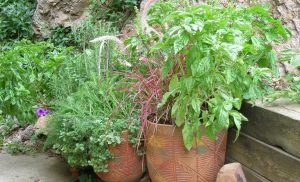
BASIL VARIETIES
Tulsi Basil, Holy Basil
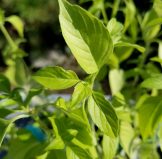 Native to India and used in Indian and Thai cuisine, Tulsi is spicier than other basil varieties, and quicker to go to seed, but still usable when covered with purple flowers. Used in Ayurvedic medicine as a poultice on acne, ringworm, eczema, and insect bites, it also makes a delicious tea that strengthens the immune system and increases oxygen uptake in the brain. The aromatic leaves can also be used in salads, cooking, or herb butter. Also said to repel mosquitoes. Its compact growth habit makes it an excellent subject for container growing. Tulsi basil plants can stand a bit more cold than other basils.
Native to India and used in Indian and Thai cuisine, Tulsi is spicier than other basil varieties, and quicker to go to seed, but still usable when covered with purple flowers. Used in Ayurvedic medicine as a poultice on acne, ringworm, eczema, and insect bites, it also makes a delicious tea that strengthens the immune system and increases oxygen uptake in the brain. The aromatic leaves can also be used in salads, cooking, or herb butter. Also said to repel mosquitoes. Its compact growth habit makes it an excellent subject for container growing. Tulsi basil plants can stand a bit more cold than other basils.
Nufar Genovese Basil
Also called Perfumed Basil, Genovese basil is the choice of many connoisseurs for making Pesto Genovese. Leaves are slightly smaller and finer than Sweet Basil, with a bit more aroma and potency. Nufar is a strain of Genovese Basil that was bred for authentic flavor and resistance to fusarium wilt.
Sweet Basil
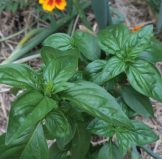 Sweet Basil is a classic Italian variety that is prized for its large, thick leaves, wonderful aroma, and spicy flavor. If you are making pesto, this is the basil for you! The heaviest-yielding variety, Sweet Basil plants will grow rapidly to 18-24” tall. Make successive cuttings for a steady supply and make sure to dry and freeze some for winter use. It does well in hot weather and can be harvested several times until the weather turns cool.
Sweet Basil is a classic Italian variety that is prized for its large, thick leaves, wonderful aroma, and spicy flavor. If you are making pesto, this is the basil for you! The heaviest-yielding variety, Sweet Basil plants will grow rapidly to 18-24” tall. Make successive cuttings for a steady supply and make sure to dry and freeze some for winter use. It does well in hot weather and can be harvested several times until the weather turns cool.
Thai Basil
 An attractive 12-18″ plant with purple stems, flowers and seed heads, Thai basil is a popular herb in Southeast Asian cuisines and is an important ingredient served with many Vietnamese dishes, like Pho. It holds its unique and sweet flavor and texture better after cooking than other basil varieties and adds a kick to salads when sliced and eaten fresh. You can use both leaves and flowers in recipes and as a garnish. Thai basil’s dark purple flowers and intoxicating scent make it a highly ornamental addition to the flower garden and a terrific container variety.
An attractive 12-18″ plant with purple stems, flowers and seed heads, Thai basil is a popular herb in Southeast Asian cuisines and is an important ingredient served with many Vietnamese dishes, like Pho. It holds its unique and sweet flavor and texture better after cooking than other basil varieties and adds a kick to salads when sliced and eaten fresh. You can use both leaves and flowers in recipes and as a garnish. Thai basil’s dark purple flowers and intoxicating scent make it a highly ornamental addition to the flower garden and a terrific container variety.
Spicy Globe Basil
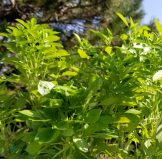 This marvelous little basil grows to about 8″ and maintains a compact mound of light green leaves and white flowers. Its leaves are small, thin, and strongly scented. Great as an ornamental border, in a window box, or as an outdoor or indoor potted plant that can be snipped for culinary use.
This marvelous little basil grows to about 8″ and maintains a compact mound of light green leaves and white flowers. Its leaves are small, thin, and strongly scented. Great as an ornamental border, in a window box, or as an outdoor or indoor potted plant that can be snipped for culinary use.
Round Midnight Basil
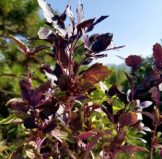 This lustrous purple basil will lure you from across the garden with its broad dark lightly ruffled and gently serrated leaves wafting a swooning aroma of allspice, nutmeg, and light musk. Noting the 12-14″ stature and well-branched uniform habit, you bend to pluck a tender leaf. Savory with mild pungency, the flavors dance on your tongue. As weeks follow, Round Midnight slowly reveals spikes of purple flowers. Seduction complete: gorgeous in salads, the flower garden and in containers!
This lustrous purple basil will lure you from across the garden with its broad dark lightly ruffled and gently serrated leaves wafting a swooning aroma of allspice, nutmeg, and light musk. Noting the 12-14″ stature and well-branched uniform habit, you bend to pluck a tender leaf. Savory with mild pungency, the flavors dance on your tongue. As weeks follow, Round Midnight slowly reveals spikes of purple flowers. Seduction complete: gorgeous in salads, the flower garden and in containers!
Italian Large-leaf Basil
Large-leaf Italian Basil produces large, light green leaves with slightly sweeter flavor than Genovese basil. It offers an excellent aroma to any meal, soup or sauce. The leaves can be large enough to use instead of lettuce for wraps. The attractive, bushy plant is fast-growing and productive.
Mrs. Burns’ Lemon Basil
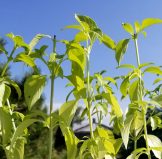 This heirloom variety has long been prized for its intense lemony fragrance and flavor. Grown 100 years ago in southeastern New Mexico by a Mrs. Clifton who gave the seed to Mrs. Burns, the mother of one of the founders of Native Seeds/Search who introduced it commercially in 1983. Since then, it has deservedly achieved nationwide fame. Its medium-sized bright green leaves have a matte surface and make a delicious tea, as well as a perky salad ingredient.
This heirloom variety has long been prized for its intense lemony fragrance and flavor. Grown 100 years ago in southeastern New Mexico by a Mrs. Clifton who gave the seed to Mrs. Burns, the mother of one of the founders of Native Seeds/Search who introduced it commercially in 1983. Since then, it has deservedly achieved nationwide fame. Its medium-sized bright green leaves have a matte surface and make a delicious tea, as well as a perky salad ingredient.
Cinnamon Basil
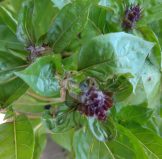 Cinnamon Basil is associated with both Southeast Asian and Mexican cuisines and is sometimes called Mexican Spice Basil. The beautiful 15” plant has strong violet stems and veining with lavender flowers leaves, all of which have a spicy cinnamon-like aroma and flavor. Eve would not be without Cinnamon basil and grows it every year! She uses the leaves to make exceptional pesto, and she pinches off the flower clusters before they open and puts them in a bowl to dry thoroughly before storing them in a jar. She crumbles the uniquely flavored dried buds into omelets, savory pancakes, bean dishes, salad dressings, Mexican dishes, and more.
Cinnamon Basil is associated with both Southeast Asian and Mexican cuisines and is sometimes called Mexican Spice Basil. The beautiful 15” plant has strong violet stems and veining with lavender flowers leaves, all of which have a spicy cinnamon-like aroma and flavor. Eve would not be without Cinnamon basil and grows it every year! She uses the leaves to make exceptional pesto, and she pinches off the flower clusters before they open and puts them in a bowl to dry thoroughly before storing them in a jar. She crumbles the uniquely flavored dried buds into omelets, savory pancakes, bean dishes, salad dressings, Mexican dishes, and more.
